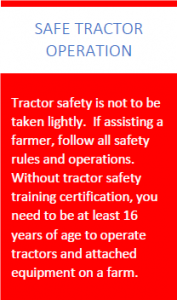Agriculture in Wisconsin is a leading industry generating $104 billion per year. Farms are the origin of the food industry. The health of farmers is instrumental at the start of a safe and secure food system. For this reason, farmers and their families need to stay healthy. This year it may be prudent to have a clear and easily available field, planting, and harvest plan for family, friends, and neighbors to use in case the farm’s manager is ill or unable to perform or direct field operations.
Farms need to follow their biosecurity plans and protocols. If a farm does not have a biosecurity plan, one should be developed as soon as possible. Additional biosecurity resources are available. Follow all recommended cleaning, sanitizing, and hand washing protocols.
 The farm field plan does not have to be complicated, just a simple listing of field operations, decisions, and how they get done. Some items to consider in a field plan are explained below.
The farm field plan does not have to be complicated, just a simple listing of field operations, decisions, and how they get done. Some items to consider in a field plan are explained below.
Field Maps
The farm field plan should include a map of fields with field entrances marked. A route to get to field would be helpful if fields are not located near the farmstead. The map should include areas where planting and tillage will not occur such as buffer strips, waterways, etc. Field maps can be obtained from your Local FSA Office or be printed from several free internet sources such as Google Maps.
Tillage
The list or field maps should include the types of tillage to occur on specific fields. Specific information such as depth of tillage, hydraulic settings, and number of passes should be included for the crop to be planted. An important detail to include is the tractor or power equipment that should be attached to the tillage equipment. Include secondary power sources if there is a breakdown of the primary tractor or power unit.
Planting
The farm field plan should include crop to be planted, variety, seeding rate, planting equipment to use, and who the seed is purchased from. Remember to include where seed is stored and categorized so those helping know where seed products are located. This can help if seed is yet to be delivered and all farm employees know where seed should be stored. Include a contact name and number for your seed supplier.
It is important to include on the field map or list what crop is to be planted in the specific fields. Hybrid and varieties planned for specific fields need to be identified. Other details to include in the field plan are seeding rates, how to adjust seeding rates on the planting equipment, seed depth placement, and how to adjust the seeding depth. Tractor operation selections such as gear, throttle, and tachometer speed should be noted so planter operation is optimized.
If starter fertilizer is applied at planting, detailed instructions are needed on how to load starter fertilizer and set application settings on the equipment. Include the rate of starter fertilizer to apply so those doing the planting can determine the application is accurate during the planting operation.
Fertilizer and Crop Protection Products
Farm field plans need to include the fertilizer and crop protection products planned for the crop. Application rates and types of fertilizers to be used are hopefully identified in a nutrient management plan and can be easily included in the field plan. Crop protection products and rates such as herbicides, insecticides, and fungicides need to be included to ensure proper communication with custom applicators. If the farm manager has a Private Pesticide Applicators License, no others can apply restricted use pesticides.
If crop protection products can be applied by employees or emergency help, these people must be trained. Product labels must be followed. Application protocols and sprayer operation needs to be detailed and include personal protective equipment, mixing instructions, and sprayer operation. Sprayer operation should include nozzle types, pressure and speed of operation settings. Include locations where products are stored and where equipment should be filled and washed as well as phone numbers and names for product suppliers.
If fertilizer and crop protection products are applied by a coop or ag retailer, include the name of each company used, what product or products they apply, and a contact name and phone number for each. Include a farm name and field names to reference when contacting these service providers.
Cultivation/Rotary Hoe
Operation of a cultivator or rotary hoe for weed control should include the specific tractor to attach to the equipment. Details should include the depth settings, gear selection, and tachometer speed.
Hay Harvest
The farm field plan should include where fields are located and access and entrance to them. Details should include operation of mowers, rakes, mergers, and chopping equipment. The power units to be attached to this equipment needs to be identified. Settings for each of these needs to be included for proper harvest of quality hay. Consider mowing height, rake and merger adjustments, and length of cut preferred. Storage location of hay crops such as silage bag location, silage pile/bunker construction, and packing instructions should be detailed in the plan.
A farm field plan can include maps of fields with operations to occur in those field with detailed operations for those fields.
A list of contacts for assistance with planting operations can be helpful.
A Farm Continuation Plan template is provided to assist in development of field plan.




